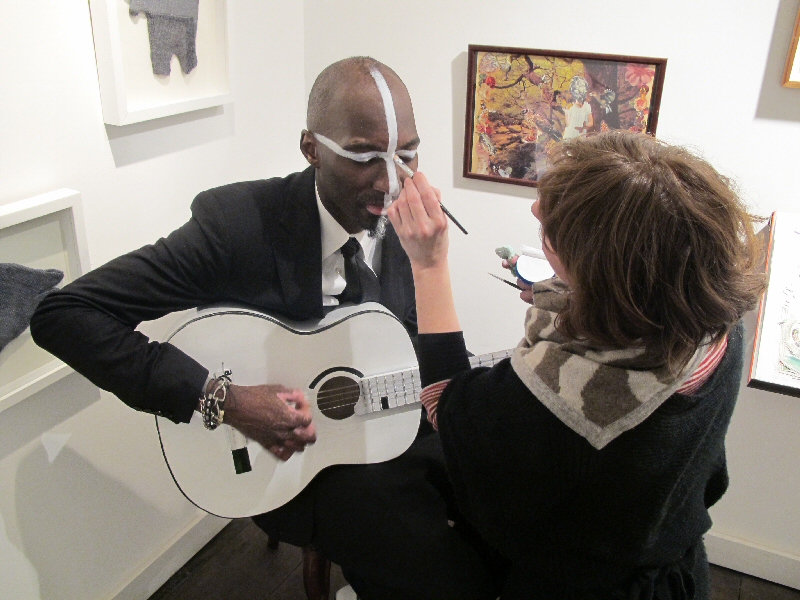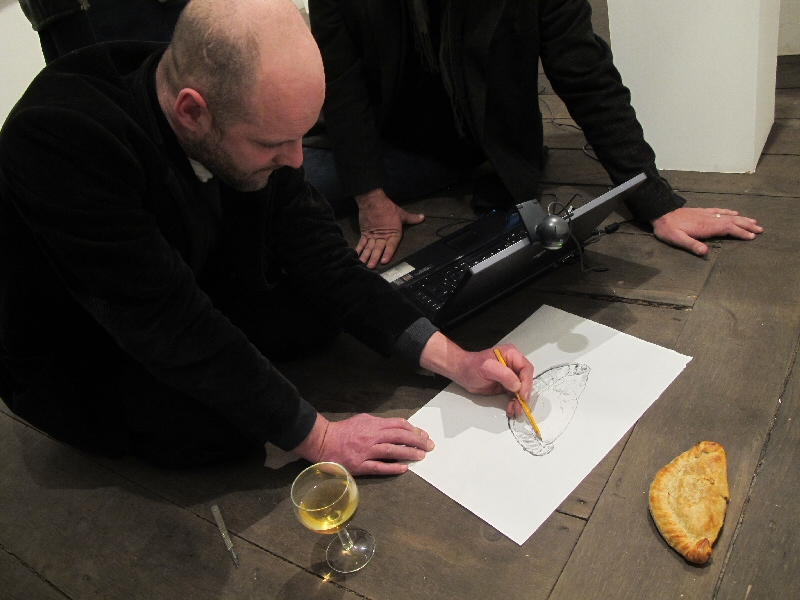|
|
| home | features | exhibitions | interviews | profiles | webprojects | gazetteer | links | archive | forum |
|
A little local difficulty: Gavin Turk and pasty politics Rupert White
It's unusual to see art from Cornwall that explicitly announces its Cornishness. Traditional icons of Cornwall, together with linked considerations of Cornish culture, history and political independence, seem so completely off-limits to artists in Cornwall that this neglect is, at the very least, deserving of closer scrutiny. It seems everyone is basically either oblivious to the issue, or, more likely, gripped by a lack of confidence and paranoia: by a fear of appearing like 'locals', or in-breds from the League of Gentlemen. So, for example, there has never to my knowledge been a pasty in a work of art from Cornwall. (At this point I should admit to some pasty-bias and claim something of a first in that, whilst I have never actually cooked one, I did make some tasty 3D computer models of a pasty a few months ago - now in Google's 3D warehouse. Also Hedluv and Passman, fine Cornish rappers that they are, did have a section on their website dedicated to pasty-tasting, but even they have now removed it). I guess the problem is, it's hard to sex-up a pasty. They're just not sushi. Pasties aren't cool. Are they?
St Piran's flag, again, rarely features in art from Cornwall (though was part of Swiftie's Anti-Swiftie campaign: used in fact as a symbol of bigotry and conservatism). The Cornish language hasn't been used in any works by artists based down here either (with a recent exception being Janet McEwan's Hedorr...Fragile). Even a legend like Tristan and Isolde, which is one of the oldest and most enduring of all love stories, and one set in Cornwall, has not been used as material for any recent or contemporary artworks. And the Cornish chough has again, suffered a similar fate. Sadly cancelled from lack of interest (apart from The Chough Project). Tin mines have fared better. Or at least they have featured as locations for shows like Wheal Art Weekend of 2006 and Mined of 2008. But iconic images of tin-mines? Works that question, play or challenge our perception of such images? Seemingly off limits, again. (Though an exception here might be Paul Chaney's little models that featured in Wheal Art). Admittedly Nigel Ayers and Andrew Lanyon, both visionary artists, have made strong reference to Cornwall in their work (see the former's online 'Space Cornish' project, for example), but apart from images of the landscape itself, surfing is the only aspect of Cornish culture to have had more consistent representation. But then it's hipper and sexier than the other bits, which is probably why artists like Ben Cook and Andy Hughes (and writers like Alex Wade) have felt comfortable exploring its iconography. Given my concern at what appears to be a kind of void, or unchallenged lethargy, sitting at the heart of the contemporary self-image of Cornwall, it was with interest that I heard that the night before the opening of House Of Fairy Tales at Millennium in St Ives which was March 5th, or St Piran's day, not only had musician and artist William Fontaine planned to paint his face to look like a St Piran's flag, but Gavin Turk had decided to make a drawing of a pasty, as a kind of live performance.
Honoured to provide the webcam and laptop that ultimately created the fragrant pasty-line to the metropolis, the idea was that, together with Maria Teresa Gavazzi and Kate Walters, both would be beaming their works via the internet to the ICA in London, who were simultaneously staging 'Kernow in the City' with Louis Eliot. This would, then, be a pasty projected on the wall of the so-trendy-it-hurts ICA, by a very astute and celebrated artist who over more than a decade has embraced all manner of 20th (and 21st) century icons in his work, often carefully chosen for their ability to provoke. Talking to Turk at the time he modestly claimed that his contribution to the evening was, basically, playful and jokey, like much of his art. But, I would argue, it's also a rather provocative piece. There are different opinions on the issue of Cornish cultural icons, but I am reminded of an economic model, whereby Cornwall can be thought of as a brand. Its iconography, however cliched, then becomes a device that creates distinctiveness in an otherwise over-crowded market-place. It seems worth preserving or reinventing for a new generation, as it may also be, more profoundly, something that helps us to resist passively accepting the colonising, or reterritorialising, processes of globalisation. The House of Fairy Tales is at Millennium, St Ives 6/3/10 - 28/3/10
http://www.nigelayers.com/spacecornish.html http://www.myspace.com/louiseliot http://www.artcornwall.org/webprojects/Janet_McEwan.htm
|
|
|


